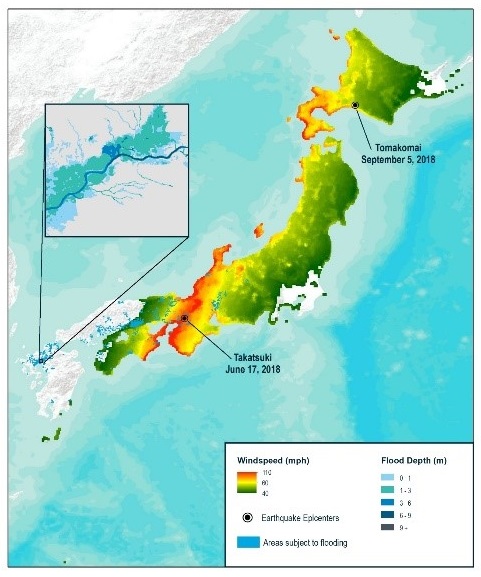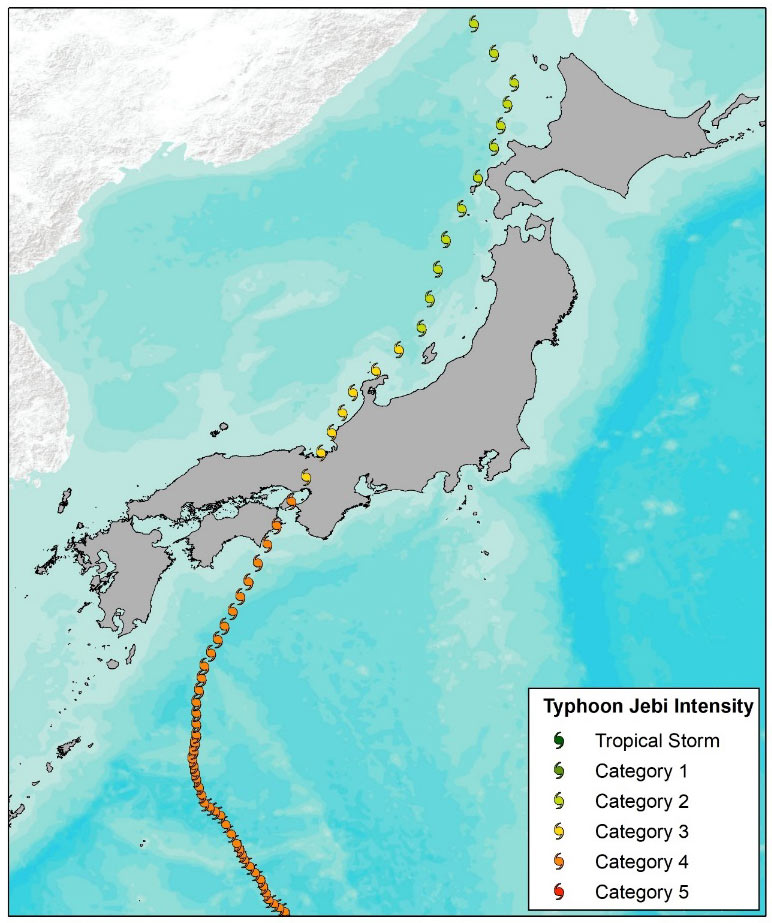
2018: Japan’s Year of Catastrophes
Apr 24, 2019
Editor's Note: Beginning nearly one year ago, a devastating series of inland floods, typhoons, and earthquakes in Japan tested the insurance industry’s resilience. This article explains the value of taking a holistic view of risk across perils and what role catastrophe models play in helping companies understand their aggregate loss potential. (All losses given are as of March 11, 2019.)
Globally, 2018 was a costly year for catastrophes, following significant losses in 2017. Asia experienced the greatest number of catastrophes. While Japan registered only 14 events, five of them incurred more than USD 1 billion in economic losses. The summer saw a relentless onslaught of natural catastrophes, beginning with an M5.5 earthquake in mid-June which was followed by flooding in late June/early July, Typhoon Jebi in early September, an M6.6 earthquake soon after, and finally Typhoon Trami in late September. For the Japanese insurance industry, this was the costliest year for natural disasters since 2011 when the M9.0 Tohoku earthquake and tsunami struck. The combined insured losses from these five events in 2018 serve as a reminder that accounting for aggregate losses across multiple perils is critical to understanding and managing risk.

Largest Insured Loss Event in Japan: Typhoon Jebi
Worldwide last year, the Camp Fire in California topped the list of insured losses, followed by Hurricane Michael, and Typhoon Jebi rounded out the top 3. Typhoon Jebi initially struck Shikoku, the smallest of Japan’s four main islands, on September 4. The equivalent of a Saffir-Simpson Category 3 hurricane when it made landfall, Jebi was the most powerful typhoon to hit in Japan in 25 years. A second landfall followed near the city of Kobe, 30 km west of Osaka, on neighboring Honshu, the largest and most populous of the main islands. Major cities in the Kansai region, among them Osaka, Kyoto and Kobe, were brought to a halt.
Because soils had already been saturated after a series of storms, the Japan Meteorological Agency (JMA) issued warnings for potential flash floods and landslides. As Jebi’s center propagated inland, a squall line of intense convection formed near Osaka and devastated the region. The typhoon caused major damage to buildings and infrastructure, seriously impacted shipping and transportation, and led to significant business interruption.
Months after the event, claims arising from the typhoon are still being filed. But with more than USD 8 billion in insured claims already reported, Jebi is firmly established as Japan’s biggest typhoon-related insurance and reinsurance loss on record. If typhoons Kathleen, Ida, or Vera were to recur today, however, any one of them would result in higher losses.

Snapshot of Catastrophes Impacting Japan in Summer 2018
Late June/Early July Floods
A near-continual series of heavy downpours that soaked southwestern Japan in late June and early July caused widespread floods and landslides. Fifteen prefectures, most of which were in Honshu, were impacted; Hiroshima and Okayama were the hardest hit. This was Japan’s deadliest freshwater flood-related disaster—the lives of at least 225 people were lost—since the 1982 Nagasaki flood.
The precipitation began on July 4 as a seasonal “Baiu” rain front interacted with moisture from the remnants of Typhoon Prapiroon. Multiple rounds of heavy rain followed, primarily in northern Kyushu, and in a few days parts of Japan received four times the rainfall typically expected in the whole month of July, according to the JMA. Media reports noted that new rainfall records were set in 93 locations. Many rivers crested above their historic levels, floodwaters reached as high as 5 meters (16.4 feet) above normal levels, and watercourses across the region overflowed.
Because of the saturated soils there was a continuing risk of landslides; a Hiroshima University survey later found slopes to have failed at more than 7,000 locations in southern Hiroshima Prefecture. Automobile manufacturers, electronics companies, and others experienced business interruption directly or because of supply chain disruptions. Munich Re estimated insured losses from flooding alone to be USD 2.4 billion.
Mid-June and September Earthquakes
Japan is a seismically active region, with many low-intensity tremors taking place each year and significant destructive earthquakes striking several times each century. The country experienced two major temblors in 2018. Because of Japan’s strict building standards, however, damage was limited.
On June 18 northern Osaka Prefecture was struck during the morning rush hour by an M5.5 (USGS) earthquake, the strongest in the area since the first instrumental records were kept in 1923. Its epicenter was near Takatsuki and shaking was felt strongly in the nearby metropolitan areas of Osaka and Kyoto. It caused the partial collapse of several buildings and damaged hundreds of homes. Four people died and 417 were reported injured.
Nearly three months later, on September 6, the M6.6 Tomakomai earthquake struck Iburi Subprefecture in southern Hokkaido. As the earthquake's epicenter was near Tomakomai, strong shaking was felt in Hokkaido and Aomori prefectures. (In Japan, this quake was dubbed the Hokkaido Eastern Iburi Earthquake and determined to be only the sixth tremor to reach a maximum level of 7 on the Japan Meteorological Agency seismic intensity scale, or Shindo scale, since the system was put in place in 1949.)
At least 32 houses collapsed; cracks and liquefaction damaged roads as far from the epicenter as Kiyota-ku, Sapporo, making some impassable. Fire following the earthquake severely damaged the Hokkaido Electric Power Company's coal-fired power plant in Atsuma, causing a power outage for all 2.95 million households in Hokkaido. Soils in the region had been saturated from Typhoon Jebi’s passing through the previous day, so more than 3,300 landslides occurred within a 20 km2 area in the foothills near Atsuma, with some blocking roads and destroying homes. In total, 41 people lost their lives and about 680 were injured.
September Typhoons
Japan’s location in the Pacific Northwest Basin combined with its unique topography puts it at great risk from typhoon-related damage. In 2018 the country's many islands were approached by at least seven typhoons, five of which made landfall or made close bypasses, delivering high winds and heavy precipitation in the process. By far the most damaging of these storms was Typhoon Jebi in early September.
Later in the same month, however, a second major typhoon, Trami, made landfall near Tanabe City in Wakayama Prefecture. It came ashore on September 30 as a strong Category 2-equivalent storm, with 1-minute maximum sustained winds of 175 km/h (109 mph) and a minimum central pressure of 955 mb. Record-breaking winds and high tides were experienced along Japan’s Pacific coast, causing high waves and storm surge. The storm propagated north-northwest through Honshu at hurricane strength delivering more than 400 mm of total rainfall to regions of Japan, many of which had barely recovered from the catastrophic floods in July and the devastation wreaked by Typhoon Jebi. In addition to landslides and power outages, Trami caused widespread travel disruption and brought Tokyo to a standstill.
The Importance of Accounting for Aggregate Losses Across Perils
The General Insurance Association of Japan (GIAJ) estimated the combined insured losses from the five major events of 2018 to be JPY 1,584 billion (USD 14 billion) arising from 455,398 claims submitted (Table 1). Japan’s National Mutual Insurance Federation of Agricultural Cooperatives, Zenkyoren, which handles farmer’s life and non-life insurance, estimated its insured losses for these same events to be JPY 239 billion (USD 2.13 billion) (Table 1).
| GIAJ claims | GIAJ losses | Zenkyoren losses | |
|---|---|---|---|
| *Residential only **Fire (residential, commercial, and industrial) plus auto *** GIAJ updated figures for Jebi and Trami on March 11, 2019, but figures for the other events have not been altered since December 2018 | |||
| Typhoon Jebi | 943,380 | JPY 970B** (USD 8.6B)*** | JPY 80B (USD 0.71B) |
| June/July Floods | 55,280 | JPY 190B* (USD 1.69B) | JPY 55B (USD 0.49B) |
| Osaka Earthquake | 144,029 | JPY 103B* (USD 0.91B) | JPY 47B (USD 0.42B) |
| Tomakomai Earthquake | 46,595 | JPY 34B** (USD 0.30B) | JPY 7B (USD 0.06B) |
| Typhoon Trami | 466,783 | JPY 287B** (USD 2.5B)*** | JPY 50B (USD 0.44B) |
| Totals | 1,455,398 | 1,584 (USD 14B) | 239 (USD 2.13B) |
It is imperative to consider the time horizon associated with aggregate financial impacts across perils, not simply the impact of single extreme events. Potential losses can be examined for each peril individually or, because of AIR's unique year-based catalog architecture, for all three perils combined. AIR offers models for all three of the perils that impacted Japan in 2018—earthquake, typhoon, and inland flood. Our 10,000-year catalog for Japan contains 2,769 years containing at least two major earthquakes, two damaging typhoons, and serious inland flooding with losses of at least USD 1 billion each. Probabilistic catastrophe models can provide the tools to quantify the likelihood of different levels of losses, which helps companies structure appropriate reinsurance programs.
Lessons Learned
Generally, when Japan experiences high losses from natural catastrophes in a given year, earthquakes are responsible, but this was not the case in 2018. Earthquakes occur at any time of year and can affect large portions of Japan. The typhoon and flood perils are seasonal. June to September is hot and wet with substantial rainfall. The rainiest season usually lasts for the month of June, but a seasonal rainfront called baiu zensen can prolong the rainy season to mid-July. While typhoons can occur during any month of the year, most strike Japan between May and October, with July through September being peak season. The Northwest Pacific Basin produces more tropical cyclones than anywhere else in the world. Since 1951, an average of four typhoons per year have made landfall on one of Japan's four islands—and another five come within 500 km of the coastline. Approximately half the population of Japan and about 75% of total insurable assets are on a floodplain and at risk.
None of the five major events impacting Japan in 2018 caused losses anywhere near as great as the costliest earthquakes, floods, and typhoons Japan has experienced in recent years, yet 2018 was one of the costliest years on record for Japan because of the severity of the typhoon season and rainfall experienced and the losses they contributed to the combined total.
While a single large event might be easily absorbed by a reinsurance program, 2018 clearly demonstrates that the accumulation of losses across multiple perils can pose a serious challenge if the aggregate perspective is not also considered when managing risk. Catastrophe models provide scientifically sound loss simulations so that companies can understand and quantify their risk to prepare for the full range of loss outcomes, including years like 2018.
In addition, the length of time that it has taken for claims from Typhoon Jebi to develop underscores the importance of accounting for claims creep over an extended period following a major catastrophe impacting such a highly developed region. There are also many lessons still to be learned from both hazard and vulnerability perspectives, especially from Jebi, as we review the detailed information and additional data that will emerge from study of these events.
 Kazuya Fujimura
Kazuya Fujimura